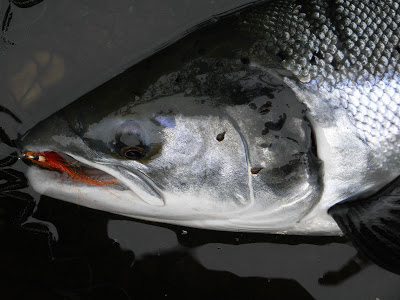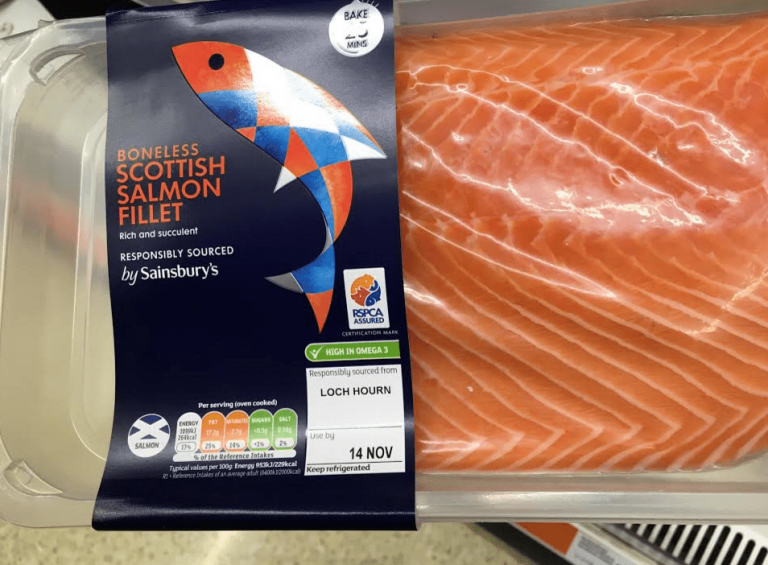Source: Salmon & Trout Conservation Scotland
Salmon & Trout Conservation Scotland (S&TCS) has again had to take Sainsbury’s to task for stocking salmon from Scottish salmon farms where sea lice infestation threatens wild salmon and sea trout. They have called on the company to refuse to accept farmed fish from sea-lice infested farms and to support the S&TCS campaign to change the law to protect wild salmon and sea trout.
A year ago, when challenged by S&TCS, Sainsbury’s acknowledged that the sea lice levels had risen to unprecedented levels on some of its supplier’s farms threatening wild salmon and sea trout with lethal infestation of these parasites – “scenarios such as that experienced in the Loch Long and Croe management area in 2014 must be avoided in future”. Sainsbury’s stated that it was “confident that this can be delivered through improved monitoring and development of a wider suite of control solutions thus reducing reliance on a relatively small number of medicines”. Sainsbury’s also reaffirmed to S&TCS its “overarching target of rearing salmon in the seawater growth phase which are free from mobile life stages of salmon lice”.

Andrew Graham-Stewart, Director of S&TCS, said:
“As part of S&TCS’ campaign to highlight the threat to wild salmon and sea trout from the huge numbers of parasites breeding on Scottish fish-farm, we have asked Britain’s leading supermarkets to examine critically their suppliers’ record and reconsider whether they should continue to sell farmed salmon from companies that operate fish-farms highlighted in the S&TCS Report (see note 2) as being in regions of Scotland that have failed to secure proper control of sea lice.
We spoke to Sainsbury’s in late 2014 and 2015 and received all sorts of reassurances, but their supplier’s farms are still causing serious concern. We don’t want any more ‘warm words’, we need action. If its assurances a year ago are to be taken seriously, we believe Sainsbury’s must now refuse to take fish from farms if sea lice numbers have gone over and stayed over the industry’s Code of Good Practice (CoGP) thresholds for sea lice for any length of time”.
The most recent sea lice figures for the Loch Long and Croe management areas (covering Sainsbury’s supplier Marine Harvest’s farms at Loch Duich, Loch Alsh and Ardintoul) show lice numbers have again, in late 2015, gone over the CoGP adult female sea-lice thresholds, as the biomass of farmed fish on the farms has risen. By December 2015, the levels were already nearly seven times the threshold (on average reaching 6.78 adult female sea lice per farmed fish).
Contrast this to what Sainsbury’s had said last year, that its supplier, Marine Harvest had committed to adopting a target of 0.1 mature female lice per fish duration sensitive periods for wild fish on certified farms, with Sainsbury’s adopting a ‘target’ for zero presence of such life stages during the entire seawater phase.
The most recent lice problem occurred despite Marine Harvest using chemical treatments for sea lice on its farms. During the last three months of 2015, the three farms concerned have treated for sea-lice eight times, using azamethiphos and deltamethrin, but this has not solved the lice problem.
Sainsbury’s had also placed great emphasis on the use of cleaner fish – “the use of cleaner fish is undoubtedly the method which is receiving most attention at present as this has been proven as an effective control in recent years” – and told S&TCS that Marine Harvest had confirmed that all marine farms would be stocked with adequate levels of cleaner fish in 2015; S&TCS remains unconvinced that cleaner fish are a panacea.
However, on 29th July 2015, Loch Alsh was inspected by the Fish Health Inspectorate (FHI) and no cleaner fish were on site, with FHI reporting that the farm “might get wrasse or lumpsuckers, not aware of specific plans. No cleaner fish at the moment”. At the time there were 793,000 salmon on sites of average weight 830g.
On 29th September 2015, Loch Duich was inspected and the FHI reported that the “manager had hoped to have stocked wrasse (wild caught) at the start of the cycle, but not as many being caught. Thought to be getting wrasse in a couple of weeks”. At the time there were 842,769 salmon on site of average weight 1.65kg.
Fisheries scientists are firm in their conclusions that sea lice produced on fish-farms harm wild salmonids, both at an individual and at a population level. However, these threats are not being addressed by effective regulation and control of sea lice numbers on fish-farms in Scotland, which are essential to protect wild fish populations which are already significantly reduced.
Mr Graham-Stewart continued:
“West coast salmon fish-farms have long been releasing huge numbers of juvenile sea lice into the surrounding sea loch environments with serious implications for local wild salmon and sea trout populations.
All supermarkets have a huge part to play in protecting wild salmon and sea trout by making it crystal clear to the salmon farmers that they will not buy and then sell on to their customers any farmed fish from those Scottish farms that cannot or will not control their sea-lice numbers.
If Sainsbury’s wants to demonstrate its real commitment to wild fish conservation, we would like to invite it to support the S&TCS Petition to the Scottish Parliament, which seeks to change the law, firstly to require immediate culls or harvesting of farmed where sea lice numbers have effectively gone out of control and secondly to give inspectors the legal duty to control sea lice on fish farms, expressly to protect wild fish populations from juvenile sea lice infestation from marine cage fish farms.”

